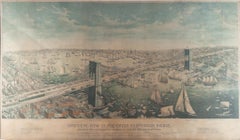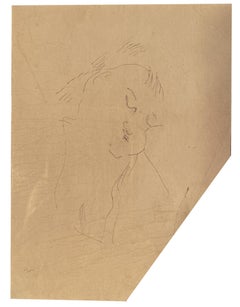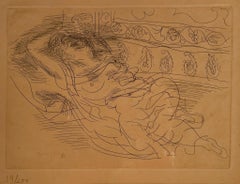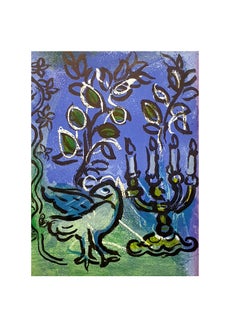Rafael Gallery Prints and Multiples
to
10
7
6
4
6
1
1
1
1
Overall Height
to
Overall Width
to
1
1
5
3
2
2
2
1
1
1
1
1
1
1
1
1
1
1
2
1
7
1
2
1
1
1
1
4
4
2
2
Vitraux in Four Sheets Puzzle of Life by Salvador Dali
By Salvador Dalí
Located in New York, NY
Vitraux in Four Sheets, Puzzle of Life, 1974, by Salvador Dali (1904-1989)
Lithograph on paper
52 ¼ x 55 ½ inches unframed (132.715 x 140.97 cm)
53 ½ x ...
Category
1770s Surrealist More Prints
Materials
Lithograph
Rembrandt Etching Framed
By Rembrandt van Rijn
Located in New York, NY
Original Self-Portrait Etching by Rembrandt van Rijn (1606-1669)
Etching on paper
2 ⅛ x 1 ¾ inches unframed (5.4102 x 4.445 cm)
14 ⅛ x 12 ½ inches framed (35.8902 x 31.75 cm)
Description:
Rembrandt van Rijn is one of the most celebrated Dutch painters of all time, and rose to prominence in the 17th century for his characteristic use of light and contrast to convey emotion and mood. Much of his artistic practice consisted of history paintings, portraits, and self-portraits, with his rich oil paintings...
Category
17th Century Old Masters Portrait Prints
Materials
Etching
Downcast Figure
By Käthe Kollwitz
Located in New York, NY
Downcast Figure by Kather Kollwitz (1867-1945)
Etching on paper
11 ½ x 6 ¾ inches unframed (29.21 x 17.145 cm)
20 x 15 inches framed (50.8 x 38.1 cm)
Description:
In this etching,...
Category
20th Century Post-Modern Figurative Prints
Materials
Etching
Bird's Eye View Of The Great Suspension Bridge
Located in New York, NY
Bird's Eye View Of The Great Suspension Bridge
Print on paper
Description:
The Brooklyn Bridge was a cultural phenomenon when it was first built, inspiring artists, entrepreneurs, ...
Category
1880s Naturalistic Landscape Prints
Materials
Lithograph
Sleeping Figure
By Jules Pascin
Located in New York, NY
Sleeping Figure by Jules Pascin (1885-1930)
Etching on paper
5 ½ x 4 inches unframed (13.97 x 10.16 cm)
13 ¼ x 12 inches framed (33.655 x 30.48 cm)
D...
Category
20th Century Figurative Prints
Materials
Etching
Reclining Nude
By Raoul Dufy
Located in New York, NY
Reclining Woman by Raoul Dufy (1877-1953)
Etching on paper
5 ½ x 7 ½ inches unframed (13.716 x 19.05 cm)
13 ⅝ x 15 inches framed (34.6202 x 38.1 cm)
Signed on bottom left
Edition of ...
Category
20th Century Figurative Prints
Materials
Etching
Fishers
By Reuven Rubin
Located in New York, NY
Fishers, ca. 1960, by Reuven Rubin (1893-1974)
Lithograph on paper
19 × 13 ⅜ inches unframed (48.26 x 33.985 cm)
Signed on bottom right
inscribed (330110 #01 x8345) on reverse bottom...
Category
20th Century Post-Modern Figurative Prints
Materials
Mixed Media, Lithograph
Mother and Child
By Reuven Rubin
Located in New York, NY
Mother and Child by Reuven Rubin (1893-1974)
Pencil on paper
25 ¼ x 19 ¼ inches unframed (64.135 x 48.895 cm)
35 ¼ x 29 ½ inches framed (89.535 x 74.93 cm)
Signed on bottom right
De...
Category
20th Century Figurative Prints
Materials
Lithograph, Mixed Media
Industry
By Earl Marshawn Washington
Located in New York, NY
Industry, 1928, by Earl Marshawn Washington (b. 1962)
Woodcut relief on paper
12 x 9 inches unframed (30.48 x 22.68 cm)
Signed on bottom left
Inscribed (Industry) on bottom center
Da...
Category
Early 20th Century Post-Modern Landscape Prints
Materials
Ink
Bethlehem Steel
By Earl Marshawn Washington
Located in New York, NY
Bethlehem Steel, 1939, by Earl Marshawn Washington (b. 1962)
Woodcut relief on paper
9 x 12 inches unframed (22.68 x 30.48 cm)
Signed on bottom left
In...
Category
Early 20th Century Post-Modern Figurative Prints
Materials
Ink
Related Items
Marc Chagall - Daphnis and Chloé - Original Lithograph
By Marc Chagall
Located in Collonge Bellerive, Geneve, CH
Marc Chagall - Daphnis and Chloé - Original Lithograph
From the literary review "XXe Siècle"
1960
Mourlot N°227
Dimensions: 32 x 24 cm
Publisher: G....
Category
1960s Surrealist Figurative Prints
Materials
Lithograph
H 12.6 in W 9.45 in D 0.04 in
Marc Chagall - The Candlestick - Original Lithograph
By Marc Chagall
Located in Collonge Bellerive, Geneve, CH
The Candlestick, from Jean Leymarie, Vitraux pour Jérusalem (Jerusalem Windows), André Sauret, Monte Carlo, 1962 (see M. 366-72; see C. books ...
Category
1960s Surrealist Figurative Prints
Materials
Lithograph
Original Vintage Salvador Dali Exhibition Poster Featuring The Face Of Mae West
By Salvador Dalí
Located in London, GB
Original vintage advertising poster for a Salvador Dali exhibition at the Zurich Art House / Kunsthaus from 18 August to 22 October 1989 featuring a su...
Category
1980s Surrealist More Prints
Materials
Lithograph
Adam Elsheimer, etching after a painting of Elsheimer by Jan Meyssens
By Wenceslaus Hollar
Located in New York, NY
Wenzel Hollar (1607-1677), Adam Elsheimer, etching after a painting of Elsheimer by Jan Meyssens, 1649, with text and signatures as described below. Ref...
Category
1640s Old Masters Portrait Prints
Materials
Etching
Pleni Luna Lune Haute 1974
By Wifredo Lam
Located in Miami, FL
Wifredo Lam
"Pleni Luna Lune Haute" 1974
Lithograph
Ap 4 of 10
25 x 19 in
Category
1970s Surrealist More Prints
Materials
Lithograph
Morning Walk. [Central Park.]
By Harold Altman
Located in New York, NY
Signed and titled in pencil. Inscribed "192/285." Edition 285.
Category
1980s Naturalistic Landscape Prints
Materials
Lithograph
Hummingbirds: 19th C. Gould Hand-colored "Cyanifrons", Blue-capped Saucerottia
By John Gould and Henry Constantine Richter
Located in Alamo, CA
This is a hand-colored folio sized lithograph entitled "Saucerottia Cyanifrons", Blue-capped Saucerottia Hummingbirds by John Gould, published in his "A Monograph of the Trochilidae, or Family of Humming-birds", published in London in 1850. The print, which was drawn by Gould and Henry Richter and lithographed by Hullmandel and Walton, depicts two green, blue and a little brown colored hummingbirds about a plant with green leaves and pink flowers.
This beautiful Gould hand-colored hummingbird lithograph has a few very small faint spots, but it is otherwise in excellent condition. The original text page is included.
There are other unframed Gould hummingbird...
Category
Mid-19th Century Naturalistic Animal Prints
Materials
Lithograph
Marc Chagall - The Tables of the Law - Original Lithograph
By Marc Chagall
Located in Collonge Bellerive, Geneve, CH
Marc Chagall - The Tables of the Law - Original Lithograph
1962
Printed by Mourlot
Dimensions: 32.5 x 24.5 cm
Publisher: André Sauret, Monte-Carlo
Reference: Mourlot n° 365
Unsigned...
Category
1960s Surrealist Figurative Prints
Materials
Lithograph
H 12.8 in W 9.65 in D 0.04 in
After Pablo Picasso - Peace Circle - Lithograph
By (after) Pablo Picasso
Located in Collonge Bellerive, Geneve, CH
After PABLO PICASSO (1881-1973)
Peace Circle
Dimensions: 65 x 50 cm
Signed and dated in the plate
Edition Succession Picasso, Paris.
Editions de la Paix
Picasso is not just a man and his work. Picasso is always a legend, indeed almost a myth. In the public view he has long since been the personification of genius in modern art. Picasso is an idol, one of those rare creatures who act as crucibles in which the diverse and often chaotic phenomena of culture are focused, who seem to body forth the artistic life of their age in one person. The same thing happens in politics, science, sport. And it happens in art.
Early life
Born in Malaga, Spain, in October of 1881, he was the first child born in the family. His father worked as an artist, and was also a professor at the school of fine arts; he also worked as a curator for the museum in Malaga. Pablo Picasso studied under his father for one year, then went to the Academy of Arts for one year, prior to moving to Paris. In 1901 he went to Paris, which he found as the ideal place to practice new styles, and experiment with a variety of art forms. It was during these initial visits, which he began his work in surrealism and cubism style, which he was the founder of, and created many distinct pieces which were influenced by these art forms.
Updates in style
During his stay in Paris, Pablo Picasso was constantly updating his style; he did work from the blue period, the rose period, African influenced style, to cubism, surrealism, and realism. Not only did he master these styles, he was a pioneer in each of these movements, and influenced the styles to follow throughout the 20th century, from the initial works he created. In addition to the styles he introduced to the art world, he also worked through the many different styles which appeared, while working in Paris. Not only did he continually improve his style, and the works he created, he is well known because of the fact that he had the ability to create in any style which was prominent during the time.
Russian ballet
In 1917, Pablo Picasso joined the Russian Ballet, which toured in Rome; during this time he met Olga Khoklova, who was a ballerina; the couple eventually wed in 1918, upon returning to Paris. The couple eventually separated in 1935; Olga came from nobility, and an upper class lifestyle, while Pablo Picasso led a bohemian lifestyle, which conflicted. Although the couple separated, they remained officially married, until Olga's death, in 1954. In addition to works he created of Olga, many of his later pieces also took a centralized focus on his two other love interests, Marie Theresa...
Category
1950s Surrealist Figurative Prints
Materials
Lithograph
H 25.6 in W 19.69 in D 0.04 in
Marc Chagall - Green River - Original Lithograph
By Marc Chagall
Located in Collonge Bellerive, Geneve, CH
Marc Chagall
Original Lithograph
Double-page spread from the 1974 book "Chagall" by André Pieyre de Mandiargues.
Unsigned, edition of approximately 10,000
Published by Maeght
1974
D...
Category
1960s Surrealist Figurative Prints
Materials
Lithograph
Marc Chagall - Flowered Clown - Original Lithograph
By Marc Chagall
Located in Collonge Bellerive, Geneve, CH
Marc Chagall
Original Lithograph
1963
Dimensions: 32 x 24 cm
From Chagall Lithograph II
Reference: Mourlot 399
Condition : Excellent
Unsigned and unumbered as issued
Category
1960s Surrealist Figurative Prints
Materials
Lithograph
Marc Chagall - Original Lithograph
By Marc Chagall
Located in Collonge Bellerive, Geneve, CH
Marc Chagall
Original Lithograph
1963
Dimensions: 32 x 24 cm
Reference: Chagall Lithographe 1957-1962. VOLUME II.
Condition : Excellent
Marc Chagall (born in 1887)
Marc Chagall was born in Belarus in 1887 and developed an early interest in art. After studying painting, in 1907 he left Russia for Paris, where he lived in an artist colony on the city’s outskirts. Fusing his own personal, dreamlike imagery with hints of the fauvism and cubism popular in France at the time, Chagall created his most lasting work—including I and the Village (1911)—some of which would be featured in the Salon des Indépendants exhibitions. After returning to Vitebsk for a visit in 1914, the outbreak of WWI trapped Chagall in Russia. He returned to France in 1923 but was forced to flee the country and Nazi persecution during WWII. Finding asylum in the U.S., Chagall became involved in set and costume design before returning to France in 1948. In his later years, he experimented with new art forms and was commissioned to produce numerous large-scale works. Chagall died in St.-Paul-de-Vence in 1985.
The Village
Marc Chagall was born in a small Hassidic community on the outskirts of Vitebsk, Belarus, on July 7, 1887. His father was a fishmonger, and his mother ran a small sundries shop in the village. As a child, Chagall attended the Jewish elementary school, where he studied Hebrew and the Bible, before later attending the Russian public school. He began to learn the fundamentals of drawing during this time, but perhaps more importantly, he absorbed the world around him, storing away the imagery and themes that would feature largely in most of his later work.
At age 19 Chagall enrolled at a private, all-Jewish art school and began his formal education in painting, studying briefly with portrait artist Yehuda Pen. However, he left the school after several months, moving to St. Petersburg in 1907 to study at the Imperial Society for the Protection of Fine Arts. The following year, he enrolled at the Svanseva School, studying with set designer Léon Bakst, whose work had been featured in Sergei Diaghilev's Ballets Russes. This early experience would prove important to Chagall’s later career as well.
Despite this formal instruction, and the widespread popularity of realism in Russia at the time, Chagall was already establishing his own personal style, which featured a more dreamlike unreality and the people, places and imagery that were close to his heart. Some examples from this period are his Window Vitebsk (1908) and My Fianceé with Black Gloves (1909), which pictured Bella Rosenfeld, to whom he had recently become engaged.
The Beehive
Despite his romance with Bella, in 1911 an allowance from Russian parliament member and art patron Maxim Binaver enabled Chagall to move to Paris, France. After settling briefly in the Montparnasse neighborhood, Chagall moved further afield to an artist colony known as La Ruche (“The Beehive”), where he began to work side by side with abstract painters such as Amedeo Modigliani and Fernand Léger as well as the avant-garde poet Guillaume Apollinaire. At their urging, and under the influence of the wildly popular fauvism and cubism, Chagall lightened his palette and pushed his style ever further from reality. I and the Village (1911) and Homage to Apollinaire (1912) are among his early Parisian works, widely considered to be his most successful and representative period.
Though his work stood stylistically apart from his cubist contemporaries, from 1912 to 1914 Chagall exhibited several paintings at the annual Salon des Indépendants exhibition, where works by the likes of Juan Gris, Marcel Duchamp and Robert Delaunay were causing a stir in the Paris art world. Chagall’s popularity began to spread beyond La Ruche, and in May 1914 he traveled to Berlin to help organize his first solo exhibition, at Der Sturm Gallery. Chagall remained in the city until the highly acclaimed show opened that June. He then returned to Vitebsk, unaware of the fateful events to come.
War, Peace and Revolution
In August 1914 the outbreak of World War I precluded Chagall’s plans to return to Paris. The conflict did little to stem the flow of his creative output, however, instead merely giving him direct access to the childhood scenes so essential to his work, as seen in paintings such as Jew in Green (1914) and Over Vitebsk (1914). His paintings from this period also occasionally featured images of the war’s impact on the region, as with Wounded Soldier (1914) and Marching (1915). But despite the hardships of life during wartime, this would also prove to be a joyful period for Chagall. In July 1915 he married Bella, and she gave birth to a daughter, Ida, the following year. Their appearance in works such as Birthday (1915), Bella and Ida by the Window (1917) and several of his “Lovers” paintings give a glimpse of the island of domestic bliss that was Chagall’s amidst the chaos.
To avoid military service and stay with his new family, Chagall took a position as a clerk in the Ministry of War Economy in St. Petersburg. While there he began work on his autobiography and also immersed himself in the local art scene, befriending novelist Boris Pasternak, among others. He also exhibited his work in the city and soon gained considerable recognition. That notoriety would prove important in the aftermath of the 1917 Russian Revolution when he was appointed as the Commissar of Fine Arts in Vitebsk. In his new post, Chagall undertook various projects in the region, including the 1919 founding of the Academy of the Arts. Despite these endeavors, differences among his colleagues eventually disillusioned Chagall. In 1920 he relinquished his position and moved his family to Moscow, the post-revolution capital of Russia.
In Moscow, Chagall was soon commissioned to create sets and costumes for various productions at the Moscow State Yiddish Theater...
Category
1960s Surrealist Figurative Prints
Materials
Lithograph







